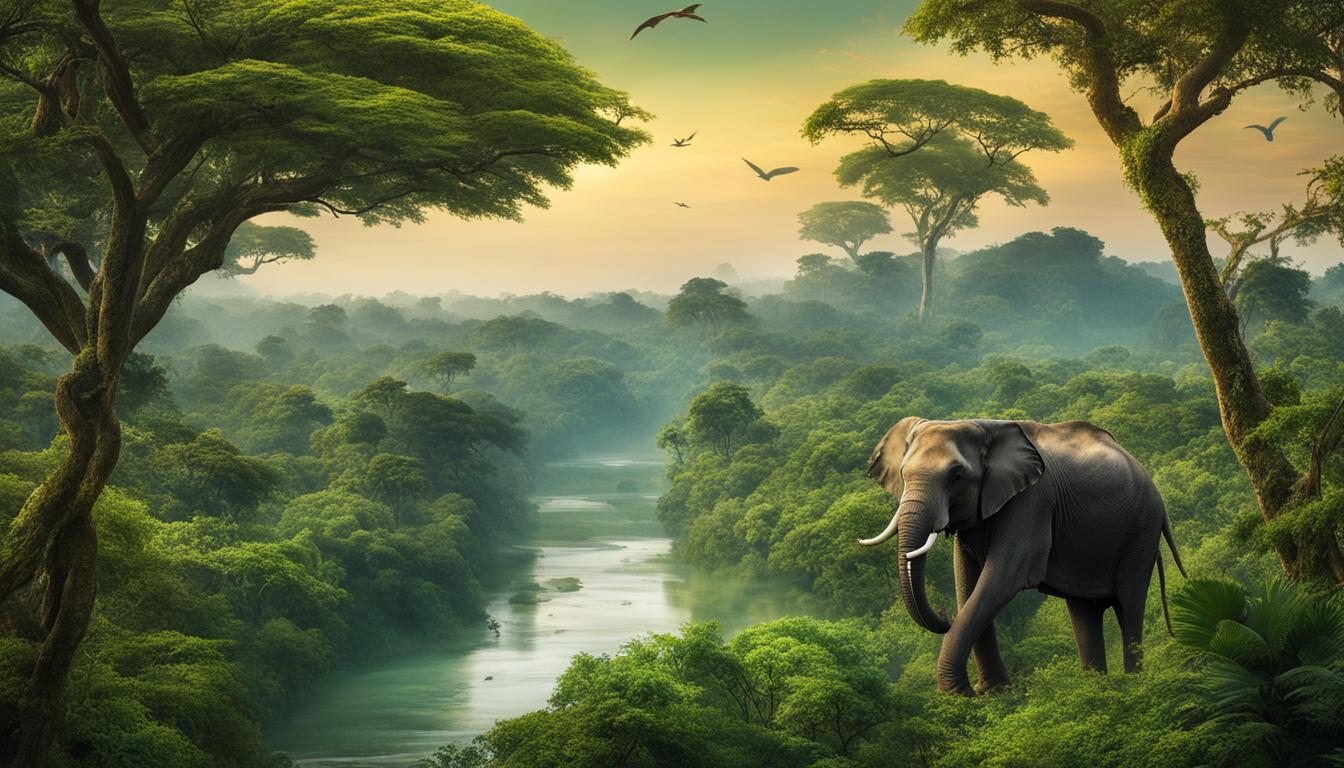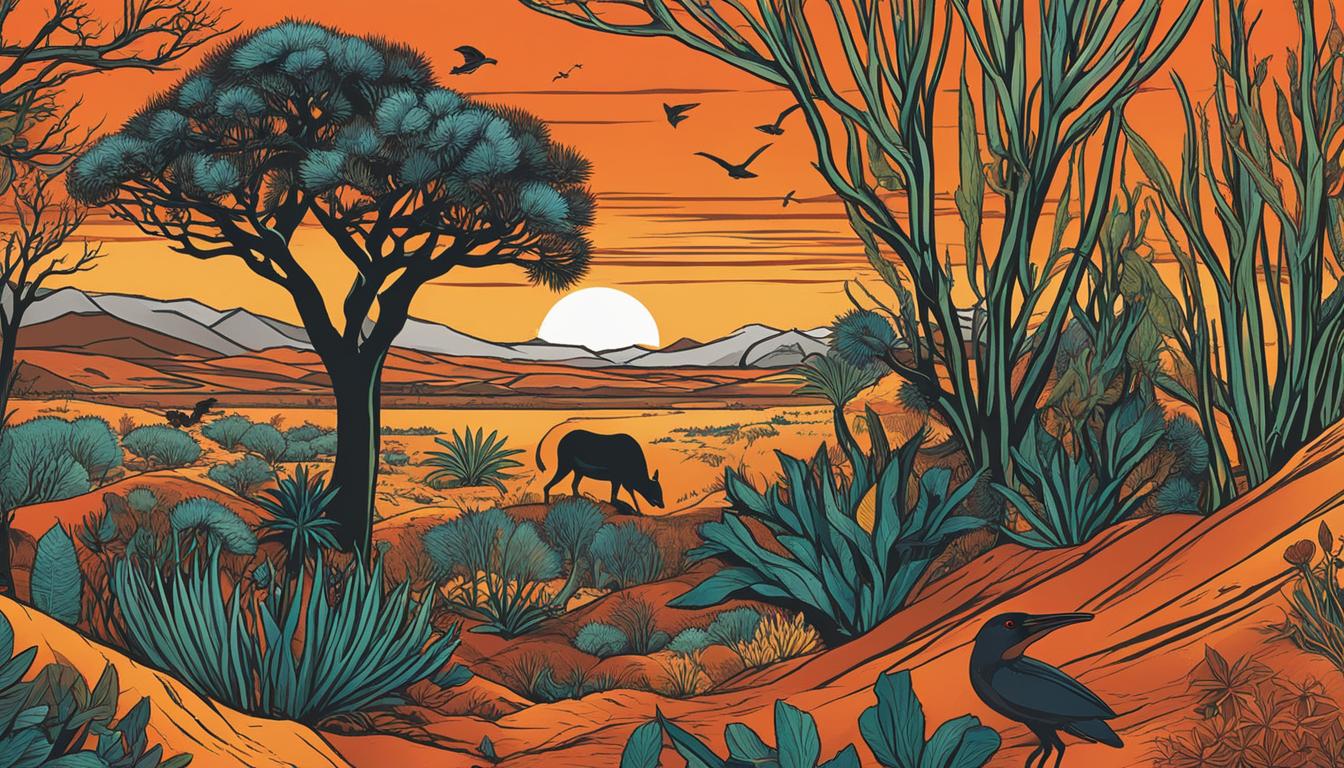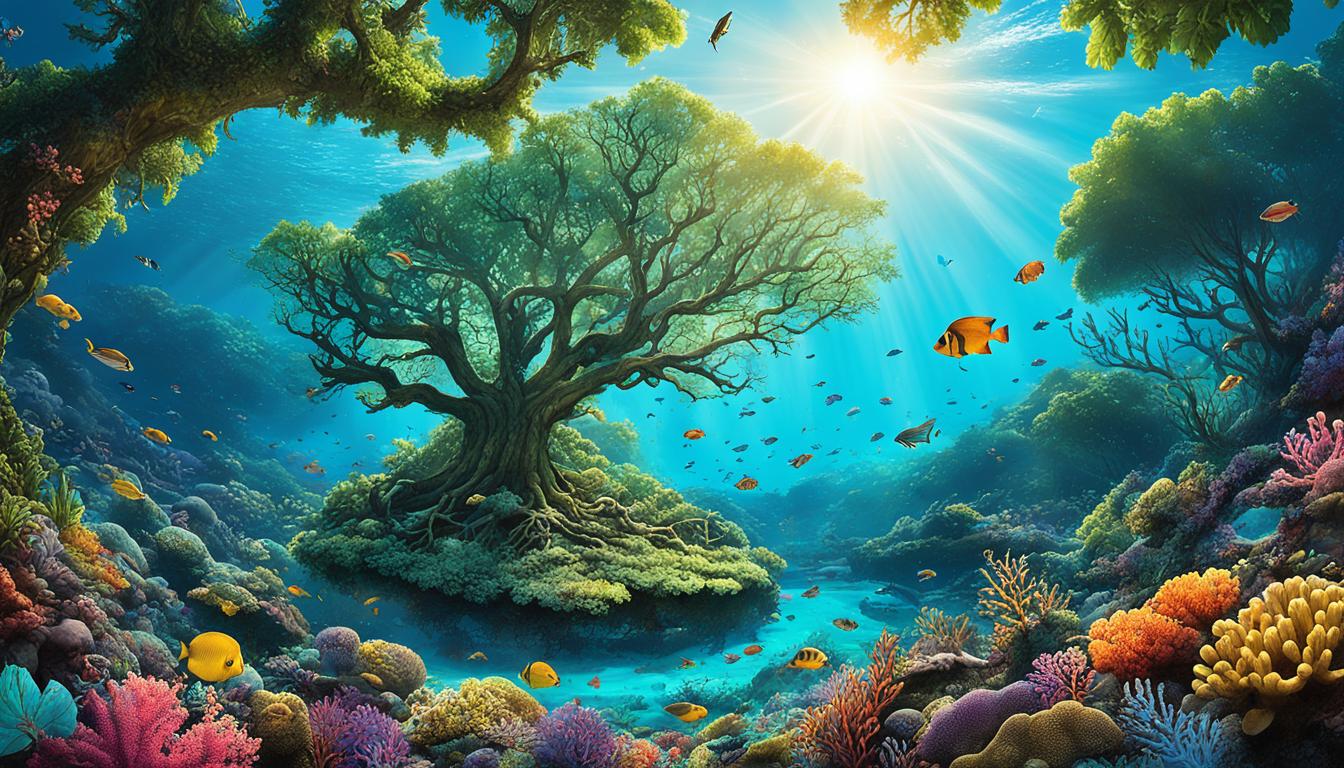Mozambique Biodiversity: Animal and Plant Species and What Is Under Threat
Located on the southeastern seaboard of Africa, Mozambique possess five phytogeographical regions with a diverse range of flora and fauna. It is home to 5,500 species of flora and 4,271 species of terrestrial wildlife, including endemic species. Mozambique is also known for its three biodiversity hotspots and unique eco-regions. However, the country face threats such as habitat loss, hunting, uncontrolled fires, vegetation clearing, and deforestation, which impact both flora and fauna.
Key Takeaways
- Mozambique is a biodiversity hotspot in Africa, with diverse plant and animal species.
- The country is known for its three biodiversity hotspots: the Coastal Forests of Eastern Africa, the Maputaland-Pondoland-Albany, and the Eastern Afromontane.
- Mozambique’s coastal areas are home to coral reefs, mangroves, and seagrass meadows, supporting a range of marine species.
- The country is also home to several endemic species, which are found exclusively within Mozambique’s borders.
- Mozambique’s biodiversity provides various ecosystem services, such as timber, water purification, and traditional medicine.
Biodiversity Hotspots in Mozambique
Mozambique, a country located on the southeastern seaboard of Africa, boasts rich and diverse biodiversity. Among its notable features are three biodiversity hotspots: the Coastal Forests of Eastern Africa, the Maputaland-Pondoland-Albany, and the Eastern Afromontane.
The Coastal Forests of Eastern Africa hotspot encompasses a unique ecosystem with plant and animal species that have adapted to the coastal environment. This hotspot is characterized by high species diversity and endemism, making it an important area for conservation efforts.
The Maputaland-Pondoland-Albany hotspot is known for its exceptional biodiversity, housing a wide range of flora and fauna. This hotspot is particularly recognized for its population of endangered species and serves as a critical habitat for their protection.
The Eastern Afromontane hotspot, with its mountainous regions, supports a diverse array of endemic plant and animal species. It is a region of ecological significance, harboring species that are found exclusively within this specific area.
These three biodiversity hotspots contribute significantly to the overall richness and uniqueness of Mozambique’s natural heritage.
| Biodiversity Hotspot | Key Features | Notable Species |
|---|---|---|
| Coastal Forests of Eastern Africa | High species diversity and endemism | Red Duiker, Angolan Colobus, Coconut Crab |
| Maputaland-Pondoland-Albany | Rich biodiversity and critical habitat for endangered species | African Elephant, Black Rhino, Leatherback Turtle |
| Eastern Afromontane | Mountainous regions and diverse endemic species | Mount Mulanje Pygmy Chameleon, African Broadbill, Aberdare Cisticola |
Marine and Coastal Biodiversity in Mozambique
Mozambique’s 2,770 km long coastline is a haven for diverse marine and coastal ecosystems. These habitats, which include coral reefs, mangroves, and seagrass meadows, contribute significantly to Mozambique’s rich biodiversity and support a wide range of marine species.
Mozambique’s coral reefs cover approximately 1,860 km2, creating vibrant underwater ecosystems teeming with life. These reefs play a crucial role in supporting marine biodiversity, providing habitats for countless species of fish, invertebrates, and plants. Notably, they are home to endangered turtles and hermatypic coral, including the magnificent Staghorn, Pillar, and Elkhorn corals.
The mangroves, spanning around 400,000 hectares, are another vital component of Mozambique’s marine and coastal biodiversity. These unique forests thrive in the transition zone between land and sea, protecting the coast against erosion and serving as nurseries for fish and other marine organisms. Mangroves provide critical habitat and breeding grounds for a variety of species, including crabs, shrimps, and several bird species.
In Mozambique’s coastal areas, magnificent marine species such as dugongs, dolphins, and whales can be found. These majestic creatures contribute to the country’s tourism industry, attracting nature enthusiasts and wildlife lovers from around the world. Mozambique’s waters are also home to a diverse range of fish species, showcasing the incredible abundance and richness of its marine ecosystem.

| Marine Habitat | Main Features | Key Species |
|---|---|---|
| Coral Reefs | Cover approximately 1,860 km2 | Endangered turtles, hermatypic coral |
| Mangroves | Span around 400,000 ha | Crabs, shrimps, various bird species |
| Coastal Waters | Home to dugongs, dolphins, whales | Diverse range of fish species |
Endemic Species in Mozambique
Mozambique is home to a remarkable array of endemic species, contributing to the country’s rich biodiversity. These unique plants and animals are found exclusively within the borders of Mozambique and play a vital role in the ecosystem.
Among the endemic species in Mozambique, there are two remarkable mammals, including the Mozambique Vervet Monkey (Chlorocebus pygerythrus) and the Mozambique Reed Frog (Hyperolius marmoratus). These creatures have adapted to their specific habitats and offer valuable insights into the country’s evolutionary history.
Additionally, Mozambique boasts an impressive collection of endemic reptile species, such as the Mozambique Cobra (Naja mossambica) and the Mozambique Girdled Lizard (Cordylus mossambicus). These reptiles are uniquely adapted to the diverse landscapes found within the nation.
Freshwater ecosystems in Mozambique are home to a range of endemic fish species, including eleven documented species. These remarkable fish have adapted to specific water conditions and are found in various river systems throughout the country. One example is the Mozambique Tilapia (Oreochromis mossambicus), a popular fish species among anglers and aquarists.
In the plant kingdom, Mozambique boasts five species of vascular plants that are found nowhere else in the world. These unique plant species, ranging from vibrant flowering plants to ancient tree species, are integral to the country’s natural heritage.
“Mozambique’s endemic species represent the country’s natural treasures. Their conservation is essential to preserve the delicate balance of the ecosystem and maintain the country’s biodiversity,” says Dr. Maria Silva, a leading expert in Mozambique’s endemic species conservation.
Efforts are underway to protect and conserve these endemic species and their habitats. Conservation organizations and government agencies collaborate to create protected areas, such as national parks and reserves, to ensure the long-term survival of these unique plants and animals.

Biodiversity Benefits and Ecosystem Services in Mozambique
Mozambique’s rich biodiversity not only sustains its unique ecosystems but also provides a myriad of benefits and ecosystem services to its population. These services contribute to the well-being and livelihoods of the people, as well as the country’s sustainable development.
One of the key ecosystem services derived from Mozambique’s biodiversity is the provision of timber for fuel and construction. The diverse range of plant species in the country allows for sustainable harvesting of timber, which is vital for meeting the energy needs of local communities and supporting the construction industry.
In addition to timber, Mozambique’s ecosystems play a crucial role in water supply and purification. Forests and wetlands help regulate the water cycle, ensuring a steady supply of clean and fresh water for both human consumption and agricultural activities.
The maintenance of soil fertility is another important ecosystem service provided by Mozambique’s biodiversity. The presence of diverse plant species improves soil structure, prevents erosion, and enhances nutrient cycling, leading to higher agricultural productivity and food security.
Mozambique’s biodiversity also contributes to flood protection, particularly in coastal areas. Coastal ecosystems such as mangroves and seagrass meadows act as natural buffers against storm surges and tidal waves, reducing the impact of flooding and coastal erosion.
Furthermore, Mozambique’s traditional medicine practices rely heavily on the country’s rich biodiversity. Plants and animals are used to extract medicinal compounds, which are used to treat various ailments and diseases. The availability of traditional medicine offers affordable and culturally relevant healthcare solutions, especially in rural communities with limited access to modern healthcare facilities.
Eco-tourism is a significant source of revenue for Mozambique, attracting tourists from around the world who are drawn to the country’s diverse wildlife and stunning natural landscapes. Tourists have the opportunity to engage in eco-friendly activities such as wildlife safaris, bird-watching, and exploring pristine marine habitats.
Overall, Mozambique’s biodiversity provides indispensable ecosystem services that contribute to the well-being of its population, support sustainable development, and promote the conservation of its natural heritage. It is crucial to continue investing in biodiversity conservation and sustainable resource management to ensure the long-term preservation of these ecosystem services for future generations.

Threats to Biodiversity in Mozambique
Mozambique’s biodiversity faces various threats that pose a significant risk to its delicate ecosystems. These threats include habitat loss and fragmentation, primarily driven by population increase and rapid development. As urban areas expand and infrastructure projects expand, natural habitats are being destroyed or fragmented, leading to the displacement and isolation of many species.
Another major threat to Mozambique’s biodiversity is hunting, which has had devastating consequences on wildlife populations. Unsustainable hunting practices and the illegal wildlife trade have resulted in the decline of numerous species, including iconic African animals like elephants and rhinos.
Uncontrolled fires, vegetation clearing, and deforestation also contribute to the decline in Mozambique’s biodiversity. These activities, often driven by agricultural expansion and logging, lead to the loss of important habitats and disrupt vital ecological processes.
The sequel follows, with deforestation being a particularly urgent problem in Mozambique. The country has experienced high rates of deforestation in recent decades, mainly due to illegal logging, agricultural expansion, and the demand for timber and charcoal. This deforestation not only threatens the survival of unique plant and animal species but also exacerbates the effects of climate change.
Political instability in the past has added to the challenges faced by Mozambique’s terrestrial fauna. Armed conflicts and civil unrest have disrupted conservation efforts and weakened governance systems, leaving wildlife vulnerable to poaching and habitat destruction.
Despite these threats, Mozambique has initiated several conservation efforts since 1992 to protect its biodiversity. These efforts aim to recover lost populations of species and safeguard critical habitats within designated conservation areas.
The significance of conserving Mozambique’s biodiversity cannot be overstated. It is essential to preserve the country’s rich natural heritage for future generations and maintain the ecological balance necessary for the well-being of both wildlife and humans.

Hunting and Deforestation in Mozambique: Statistics
| Threat | Impact |
|---|---|
| Habitat Loss | Mozambique has lost approximately X% of its natural habitat due to human activities. |
| Hunting | An estimated X number of wildlife species in Mozambique are critically endangered due to hunting and illegal wildlife trade. |
| Deforestation | Mozambique has an annual deforestation rate of X%, resulting in the loss of X hectares of forest cover each year. |
Conservation Initiatives in Mozambique
Mozambique has undertaken various conservation initiatives to safeguard its rich biodiversity. The country has established protected areas, including national parks and reserves, such as Quirimbas National Park, Limpopo National Park, and Chimanimani National Park. These protected areas serve as sanctuaries for a diverse range of plant and animal species, contributing to the preservation of Mozambique’s unique biodiversity.
In addition to protected areas, Mozambique has actively engaged in transfrontier conservation areas with neighboring countries. Notable examples include the Libombos, Great Limpopo, and Chimanimani transfrontier conservation areas. These initiatives foster collaboration between countries, enabling the creation of interconnected conservation zones that support the movement of wildlife and promote ecological well-being across borders.
By promoting biodiversity conservation and the sustainable utilization of protected areas, Mozambique’s conservation initiatives aim to safeguard the country’s natural heritage both for current and future generations. These efforts contribute to the overall preservation and enhancement of Mozambique’s extraordinary biodiversity.

Mozambique’s National Biodiversity Strategy and Action Plan
Mozambique recognizes the importance of preserving its diverse and unique biodiversity. To guide its conservation efforts, the country has developed the National Biodiversity Strategy and Action Plan (NBSAP).
The NBSAP, in accordance with the Convention on Biological Diversity, sets targets and actions for the period from 2015 to 2035. Its primary focus is to address the causes of biodiversity degradation, improve the status of biodiversity, and enhance the sharing of benefits derived from biodiversity and ecosystem services.
The NBSAP aims to integrate scientific knowledge, gender perspectives, and considerations of climate change into its strategies and initiatives. To ensure ongoing alignment with global targets and the evolving needs of Mozambique, the NBSAP undergoes regular revisions and updates.
The NBSAP plays a crucial role in shaping Mozambique’s approach to biodiversity conservation, serving as a roadmap for sustainable development and the protection of its natural resources.

| Key Highlights of the NBSAP | Biodiversity Targets |
|---|---|
| Promoting habitat conservation and restoration | Preserving and restoring critical habitats |
| Enhancing biodiversity monitoring and research | Strengthening knowledge and understanding of biodiversity |
| Addressing invasive alien species | Preventing and managing the impacts of invasive species |
| Implementing sustainable use practices | Ensuring the sustainable use of biodiversity and ecosystem services |
| Promoting public awareness and education | Raising awareness and understanding of the value of biodiversity |
Mozambique’s Efforts to Achieve the 2020 Aichi Biodiversity Targets
Mozambique has been actively working towards the achievement of the 2020 Aichi Biodiversity Targets, which aim to address the global decline in biodiversity and promote its conservation and sustainable use. The country has implemented various measures to protect and preserve its rich biodiversity, focusing on the expansion of protected areas, collaborative efforts with neighboring countries, and targeted conservation and monitoring initiatives.
One of the key actions taken by Mozambique is the expansion of protected areas, including the establishment of new national parks and reserves. By increasing the surface of protected areas, Mozambique aims to safeguard important habitats and species, ensuring their long-term survival. These protected areas not only contribute to the conservation of biodiversity but also provide opportunities for eco-tourism, boosting the country’s economy.
Mozambique has also collaborated with neighboring countries to create transfrontier conservation areas. These initiatives promote joint conservation efforts, facilitating the movement of wildlife across borders and ensuring the conservation of critical ecosystems. By working together, Mozambique and its neighboring countries can address the transboundary challenges to biodiversity conservation and achieve greater impact in protecting their shared natural heritage.
To further enhance biodiversity conservation, Mozambique has implemented measures to protect specific areas of biodiversity importance. These targeted conservation initiatives focus on preserving unique ecosystems, endangered species, and critical habitats. In addition, the country has intensified monitoring efforts to assess the status of key species and their habitats, enabling informed decision-making and adaptive management.
All these efforts by Mozambique contribute to the conservation and sustainable use of its biodiversity, aligning with the goals of the Aichi Biodiversity Targets. By prioritizing the protection of its natural resources, Mozambique is not only safeguarding its invaluable biodiversity but also ensuring the provision of essential ecosystem services and promoting the country’s sustainable development.
Mozambique’s Institutional Framework for Biodiversity Conservation
Mozambique has a diverse institutional framework for biodiversity conservation, including government institutions, non-governmental organizations, civil society organizations, and research institutions. These entities work collaboratively to protect and preserve Mozambique’s rich biodiversity.
The Ministry of Land, Environment, and Rural Development plays a crucial role in implementing biodiversity strategies and coordinating environmental activities. It ensures that conservation efforts align with national development goals and international commitments, promoting sustainable practices and safeguarding biodiversity for future generations to enjoy.
Mozambique has established a comprehensive legal framework governing biodiversity conservation. This framework encompasses laws related to the environment, land, fisheries, forestry, and conservation areas. These regulations provide a solid foundation for ensuring the effective management and protection of Mozambique’s natural resources.
| Conservation Institutions | Description |
|---|---|
| Ministry of Land, Environment, and Rural Development | The main government institution responsible for implementing biodiversity strategies and coordinating conservation activities. |
| Non-Governmental Organizations (NGOs) | NGOs actively contribute to conservation efforts through research, advocacy, awareness campaigns, and community engagement. |
| Civil Society Organizations | Civil society organizations play a vital role in raising awareness, promoting sustainable practices, and supporting biodiversity conservation initiatives. |
| Research Institutions | Research institutions conduct scientific studies, monitor biodiversity, and provide valuable insights to inform conservation strategies. |
Additionally, the government has established the National Administration of Conservation Areas (ANAC) to enhance the management of conservation areas across the country. ANAC ensures the effective enforcement of conservation laws, enhances collaboration with local communities, and promotes partnerships for the sustainable development of protected areas.
By fostering cooperation among various stakeholders, Mozambique’s institutional framework for biodiversity conservation aims to create a collaborative and holistic approach to protect its unique natural heritage.

Mozambique’s Successes and Challenges in Biodiversity Conservation
Mozambique has made significant strides in the conservation of its diverse biodiversity. Efforts to extend protected areas, increase conservation initiatives, and integrate biodiversity into national development frameworks have been key factors in preserving the country’s natural heritage. However, Mozambique still faces challenges in ensuring sustainable biodiversity conservation.
One of the major challenges is the enforcement of laws and regulations aimed at protecting biodiversity. Despite efforts to combat illegal logging, poaching, and habitat destruction, more stringent enforcement measures are needed to deter these activities and safeguard vulnerable species and ecosystems.
Sustainable resource management is another critical challenge. Balancing economic development and the exploitation of natural resources with biodiversity conservation requires careful planning and effective policies. Mozambique needs to establish sustainable practices that minimize the ecological impact of industries such as mining, agriculture, and energy while promoting biodiversity conservation.
To address these challenges, Mozambique is focused on strengthening the implementation of conservation measures and improving governance approaches. By enhancing collaboration between government agencies, civil society organizations, and local communities, Mozambique aims to develop integrated strategies that prioritize biodiversity conservation.
“Conserving Mozambique’s rich biodiversity requires a collective effort from all stakeholders,” says Dr. Maria Silva, a renowned conservation biologist. “By mobilizing resources, investing in research and monitoring, and raising awareness among the public, we can overcome the challenges and build a sustainable future for Mozambique’s natural heritage.”
Mozambique’s Successes in Biodiversity Conservation
Despite the challenges, Mozambique has achieved notable successes in biodiversity conservation:
- Expansion of Protected Areas: Mozambique has significantly expanded its network of protected areas, creating more havens for endangered species and preserving critical habitats. This includes the establishment of national parks, reserves, and marine protected areas.
- Community Involvement: Mozambique has successfully engaged local communities in conservation efforts. By involving communities in decision-making processes, promoting sustainable livelihoods, and providing alternative income sources, conservation initiatives have gained community support and generated positive results.
- Transboundary Collaboration: Mozambique has fostered transboundary conservation initiatives with neighboring countries, aiming to protect shared ecosystems and promote cross-border cooperation. Examples include the Great Limpopo Transfrontier Conservation Area, where Mozambique collaborates with South Africa and Zimbabwe to safeguard biodiversity.
- Economic Benefits: Biodiversity conservation has contributed to Mozambique’s sustainable development by fostering eco-tourism and attracting visitors interested in experiencing its unique wildlife and natural landscapes. This has generated revenue and employment opportunities for local communities.
The Way Forward
To overcome the challenges and further enhance biodiversity conservation in Mozambique, several key actions are required:
- Capacity Building: Strengthening the capacity of conservation organizations, government agencies, and local communities is crucial for effective biodiversity management. Investing in training, research, and technical expertise will empower stakeholders to make informed decisions and implement sustainable conservation practices.
- Policy Integration: Mozambique should prioritize the integration of biodiversity conservation into national policies and development plans. By considering the economic, social, and environmental dimensions holistically, the country can achieve a balanced approach that ensures long-term sustainability.
- Public Awareness: Raising public awareness about the importance of biodiversity and the benefits of conservation is essential. Educational campaigns, community outreach programs, and partnerships with media outlets can engage and inspire individuals to actively participate in biodiversity conservation efforts.
- Collaboration and Partnerships: Mozambique should continue to foster collaboration among government institutions, civil society organizations, and international partners. By working together, resources can be shared, expertise can be leveraged, and collective action can be taken to address the complex conservation challenges facing the country.
Mozambique’s commitment to biodiversity conservation is evident, and with concerted efforts, the country can overcome the challenges and secure a sustainable future for its unique ecosystems and wildlife.
Conclusion
Mozambique’s biodiversity is a precious natural asset that plays a crucial role in sustaining the country’s economy, providing essential ecosystem services, and attracting tourism. The conservation and protection of this biodiversity are fundamental for the sustainable development of Mozambique.
To ensure the preservation of Mozambique’s rich biodiversity for future generations, it is essential to maintain an ongoing collaboration between government entities, civil society organizations, and the private sector. Effective governance, resource mobilization, and the implementation of robust conservation strategies are key to achieving this goal.
By prioritizing biodiversity conservation, Mozambique can continue to reap the benefits of its natural resources while safeguarding its ecological integrity. The integration of sustainable development practices that harmonize economic growth with the preservation of biodiversity will be essential for the country to thrive in the long term.
FAQ
What is the extent of Mozambique’s biodiversity?
Mozambique possesses five phytogeographical regions with a diverse range of flora and fauna. The country is home to 5,500 species of flora and 4,271 species of terrestrial wildlife, including endemic species.
What are the biodiversity hotspots in Mozambique?
Mozambique is known for three biodiversity hotspots: the Coastal Forests of Eastern Africa, the Maputaland-Pondoland-Albany, and the Eastern Afromontane. These hotspots are characterized by high levels of species diversity and endemism.
What is the significance of marine and coastal biodiversity in Mozambique?
Mozambique’s 2,770 km long coastline is home to diverse marine and coastal habitats, including coral reefs, mangroves, and seagrass meadows. These ecosystems support a wide range of marine species and contribute to the country’s tourism industry.
Are there any endemic species in Mozambique?
Yes, Mozambique is home to several endemic species, including two species of mammals, seven reptile species, 11 species of freshwater fish, and five species of vascular plants.
What benefits does Mozambique’s biodiversity provide?
Mozambique’s biodiversity provides benefits such as timber for fuel and construction, water supply and purification, soil fertility maintenance, flood protection, and traditional medicines derived from plants and animals. The country also generates revenue from eco-tourism.
What are the threats to biodiversity in Mozambique?
Mozambique’s biodiversity faces threats such as habitat loss, hunting, uncontrolled fires, vegetation clearing, and deforestation. These factors have a negative impact on both flora and fauna.
What conservation initiatives are in place in Mozambique?
Mozambique has implemented various conservation initiatives, including the establishment of protected areas such as national parks and reserves. The country also participates in transfrontier conservation areas with neighboring countries.
What is Mozambique’s National Biodiversity Strategy and Action Plan?
Mozambique has developed a National Biodiversity Strategy and Action Plan (NBSAP) to guide its efforts in biodiversity conservation. The NBSAP sets targets and actions for the period from 2015 to 2035 and focuses on reducing biodiversity degradation and enhancing benefits sharing.
What efforts has Mozambique made to achieve the 2020 Aichi Biodiversity Targets?
Mozambique has expanded the surface of protected areas, established new national parks and reserves, and implemented measures to protect specific areas of biodiversity importance. The country has also enhanced conservation and monitoring of key species.
What is the institutional framework for biodiversity conservation in Mozambique?
Mozambique has a diverse institutional framework, including government institutions, non-governmental organizations, civil society organizations, and research institutions. The Ministry of Land, Environment, and Rural Development plays a key role in implementing biodiversity strategies.
What successes and challenges does Mozambique face in biodiversity conservation?
Mozambique has made progress in biodiversity conservation, including the extension of protected areas and increased conservation efforts. However, challenges remain in law enforcement, sustainable resource management, and balancing economic development with biodiversity conservation.
What is the importance of Mozambique’s biodiversity for sustainable development?
Mozambique’s biodiversity is a valuable natural resource that supports its economy, provides ecosystem services, and contributes to tourism. Protecting and conserving biodiversity are crucial for sustainable development in the country.








